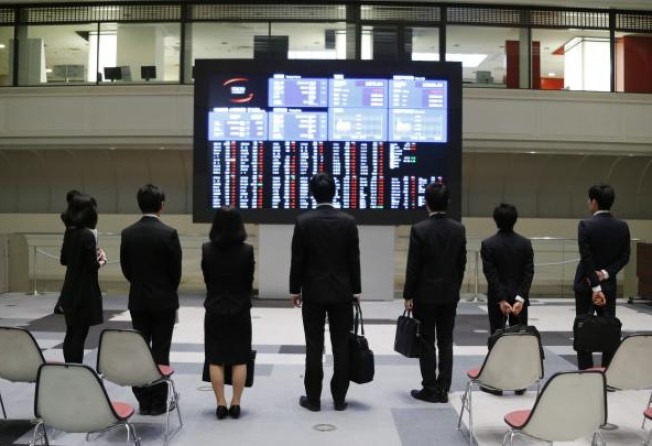Japan shares hit 5-year high on BOJ stimulus plan

Japanese shares jumped to near five-year highs and government bond prices rose sharply on Friday, a day after the Bank of Japan announced extraordinary stimulus steps to revive the world’s third-largest economy.
The massive stimulus measures promise to inject about US$1.4 trillion (HK$10.9 trillion) into the economy in less than two years by buying government bonds across the yield curve as well as riskier exchange-traded funds and
Yields on benchmark 10-year Japanese government bonds sank as much as 12 basis points to a record low of 0.315 per cent on Friday morning, while Tokyo’s Nikkei stock average jumped as much as 4.7 per cent to above 13,000 points for the first time since August 2008.
Investors cashed in some of the sharp gains in the afternoon, ahead of the key US nonfarm payroll report later in the day.
“Similar price action happened in the US after early QEs. The market rallied for a day or so but then investors rushed to lock in the windfall on their bond holdings,” said Neale Vincent, chief quantitative strategist for fixed-income at Nomura Securities in Tokyo.
The BOJ will double its monetary base to 270 trillion yen (HK$22.1 trillion) by the end of next year. The policy is unmatched in scope even by the US Federal Reserve’s own quantitative easing programme. The Fed may buy more debt, but the Japanese central bank’s stimulus is much larger as a proportion of the economy.
Credit ratings agency Moody’s Investors Service said the stimulus was likely to keep the Japanese government’s borrowing costs low over the next two years, but longer-term risks to the country’s fiscal stability remain.
The Nikkei ended 1.6 per cent higher at 12,833.64 in active trade, with volume more than double its full daily average for the past 90 trading days.
The yen hit a 3-1/2-year low of 97.20 to the dollar after dropping 3.6 per cent on Thursday, its biggest one-day fall since October 2008. By mid-afternoon, it was at 96.15, down 0.2 per cent on the day.
“It’s the biggest day in my career,” said Stefan Worrall, director of equity cash sales at Credit Suisse.
Worrall described it as a “reverse earthquake in terms of the flow”, comparing it with a massive sell-off right after the earthquake and tsunami that hit Japan in March 2011.
“This is moved by the BOJ yesterday, and it was the action from many interested investors who have yet to participate in the rally, who were sitting on the sidelines wanting to see action after all of the hype and talk from the BOJ and Abe.”
The benchmark Nikkei has surged some 48 per cent since mid-November when Prime Minister Shinzo Abe unveiled in his election campaign expansionary fiscal and monetary policies to pull Japan out of deflation. During the same period, the 10-year yield has fallen 21.5 basis points.
Shares in real estate companies jumped 11.8 per cent and financial firms also rose sharply as they were expected to benefit most from the reflationary drive.
Lender Mizuho Financial rose 1.5 per cent and was the most traded on the main board by turnover, followed by Mitsubishi UFJ Financial, Sumitomo Mitsui Financial and consumer financing firm Aiful.
In the JGB market, 10-year futures reached a record high of 146.41 before succumbing to profit-taking and the 30-year yield fell below that of 20-year debt at one point, resulting in an unusual yield curve inversion.
Naomi Muguruma, senior fixed-income strategist at Mitsubishi UFJ Morgan Stanley Securities, said the curve inverted for the first time “in a long time.”
“The supply/demand balance between 20- and 30-year JGBs was kind of distorted by the BOJ’s announcement to purchase the longer end of the curve,” Muguruma said.
“It could continue for a while, but we cannot say for sure unless the BOJ’s actual purchases begin, and that might change investors’ behaviour,” she said.
“Those who used to purchase 30-years would probably avoid buying at lower yields than the 20-year, so those investors would switch to 20-years and the inversion would be corrected. I think that’s the rational reaction expected from investors.”
The 30-year yield was last quoted at 1.210 per cent, down 1.5 basis points on the day, and the 20-year yield was unchanged at 1.135 per cent.
Yields on 10-year JGBs rose 10 basis points to 0.535 per cent on the day after earlier falling to a record low of 0.315 per cent. Ten-year futures shed 2.02 points to 144.02 to a two-month closing low.
“Many investors who were not even interested in Japan before have opened their eyes ... They realised that if they continue to look at Japan the way they did before, they are going to lose,” said Tetsuro Ii, the chief executive of Commons Asset Management.
In terms of stock valuations, Japanese equities carry a 12-month forward price-to-earnings ratio of 14.1, slightly more expensive than the US S&P 500’s 13.7 but below its 10-year average of 16.3, according to Thomson Reuters Datastream.